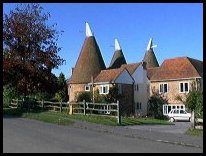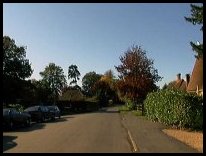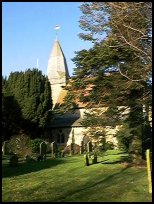|
| |
 This pretty village lies 9 miles north of Hastings
off the A229. Built along a ridge south of the River
Rother, it has spectacular views across the valley
towards Bodiam Castle.
The church of St James the Great forms an attractive
group with the cluster of old houses around it. The
church is a sturdy building, the 12th century Norman
west tower is built mostly of local ironstone. It has
a curious wood-shingled spire, which looks askew when
viewd from afar. Inside the church, the rounded nave
arcades are also Norman. The only major additions to
the church are 13th century. On the west wall is a
grotesque medieval carving, depicting a man blowing
out his cheeks. This is the sole piece of decorative
carving on the church. This pretty village lies 9 miles north of Hastings
off the A229. Built along a ridge south of the River
Rother, it has spectacular views across the valley
towards Bodiam Castle.
The church of St James the Great forms an attractive
group with the cluster of old houses around it. The
church is a sturdy building, the 12th century Norman
west tower is built mostly of local ironstone. It has
a curious wood-shingled spire, which looks askew when
viewd from afar. Inside the church, the rounded nave
arcades are also Norman. The only major additions to
the church are 13th century. On the west wall is a
grotesque medieval carving, depicting a man blowing
out his cheeks. This is the sole piece of decorative
carving on the church.
The recreation ground was left to the parish, by
Lieutenant A. Herdman who was killed in the First
World War.
Ewhurst residents were either very prosperous or
very generous, 3 centuries ago, as apparently, after
the Great Fire of London in 1666, they contributed
seven shillings and eight pence for the relief of
the poor of St Bartholomews Exchange and St Bene't
Fink of London, for their losses sustained by the fire.
A generous gesture for a remote community whose
inhabitants had probably never been to London!
We are very grateful to Stephen Wood for the following:-
A boy's recollections of Ewhurst in the 30'? Stephen Wood
A dispassionate view of the Ewhurst some 60 vears on is impossible: too much of me
is still wrapped in that small village. I hope that I might conjure up an honest, if
slightly sentimental, impression of life at that time.
We were comparatively isolated: we were a community of , perhaps 50 . There were
recognised roles at all levels from parson and farmer-squire through teacher and
publican to dairyman, carter, postman and roadman. Commonly we moved by bicycle or
on foot: horses and carts transported goods of all kinds. Bus and train services
were infrequent and, in any case, remote from the village. Cars, vans and lorries
were infrequent: the post van and the newspaper van daily, the butcher and baker
twice or three times a week. The bobby arrived on his bike about once a fortnight
unless egg-stealing or cycles without lights needed more urgent attention!
The street was our playground: we played cricket, football, hopscotch, tag and
hide-and-seek along its length. We knew and were known to all. Strangers were
reported and inspected with suspicion. We rambled the fields, woods and marshes
building dens, dams and houses, swinging on gates, whittling sticks, catching
rabbits and looking for dabchicks eggs: only the gamekeeper- and the shepherd
and the occasional farm-cart carrving hay, straw or feed interrupted our wanderings.
A 'shoeing' of a carthorse at the forge was a major event for the urchins. We knew
every spring and footpath and the name of every barn and field. We returned home
from our adventures happy, tired, hungry and usually wet. School functioned as part
of the village with activities, news, successes and failures.
The central feature of the village was Court Lodge Farm, a classic building of
dairy, fattening yards and stables with an attendant row of wretched cottages
known as 'The Barracks'. 'This useful piece of farming history was replaced by
the Green) The shop, school, church, chapel and pub were nearby.
Hop-growing featured stronglv as well as arable and animal husbandry. This brought
seasonal employment to both men, women and children as well as an annual influx
in late August of some 2000 hop-pickers from the East End and the coastal towns.
For many it was their annual holiday. This brought much social and business
activity the camps were busy centres and the pub and the shop prospered. Some
'hoppers' settled permanently but their origins were (uncharitably) always
remembered.
The farm, the pub then called the Castle Inn with its attached blacksmith's forge',
the school, the shop and Post Office, the church and occasionally the Parish Room
were the centres of activity, Christmas, Easter and Harvest celebrations were
supplemented by fetes, whist drives, sports, stoolball matches and occasionally,
plays. At one time the village boasted the 'Chief Scouts Own' troop when
Baden-Powell lived at Ewhurst Place. My particular memories are of Maypole dancing
on a small green outside the Castle Inn, of the annual exhibition of immaculate
gardens at the school and the sports day on the Recreation Ground. At Christmas
the schoolchildren used to visit the shop to choose their gift from the Herdman
Trust, For us, the children of the shop, this was a magic time: the store was packed
with Christmas goods and toys which glittered under the oil lamps of dim winter
evenings.
This time of year underlined the strength of family and friendship ties. Not only
were there the usual parties including friends but Christmas and August Bank Holiday
were the time when people who had left the village returned to call on old friends,
neighbours and relatives.
However it must be said that for working people life was hard. Both unemployment,
and ill-health posed a constant threat. Houses were frequently damp, ill-maintained
and often dirty. The Relieving Officer and the District Nurse were all too familiar
visitors. The local GP came from Northiam (a far country - 3 miles away!) and
although he was both devoted and generous medical bills were to be dreaded. Both
TB and cancer were mentioned in hushed voices.
Hop-growing was then labour-intensive and seasonal and brought some supplementary
income to hard-pressed households. However, regular jobs were precious and at the
whim of employers. Large families found themselves constantly in debt and were
often tided over by my father (the local shop-keeper) when a new baby arrived or
winter clothes were needed. One looks back nostalgically at this oddly assorted
group of people with the network of relationships and friendships which shaped
our youth. In a strange way we were dependent upon one another. No such network
now exists: the village is a commuter suburb where few seem to know one another.
The farm, the chapel, the smithy, the shop and Post Office and the school are gone.
The oast, and the Parish Room are tarted up and taken over as residences. The Church
struggles to maintain the building and the spit-and-sawdust Castle Inn is now the
bijou White Dog. The footpaths are lost and does anybody now know the field-names?
The village name is now Ewhurst Green in East Sussex: how dare they ! That used to be a place in
Surrey which has usurped our proper title!
There is much more to tell but old men bathe in the memories. Time to end
A very personal note.
I remember 'Tiddlem' Kemp - blacksmith, publican, sexton and roadman. Abrupt, rude
and kindly by turns. His name remains on the entry to the old church path as
'A Kemp, Fecit' with a date I forget. Farewell, old friend along with all the
other village characters too numerous to mention! They flit like ghosts through
my memory.
Who remembers Dan Tucker, Joe Tapp, Ronald West, Mrs Gertrude Townsend.
'Fat Harry' Willard, Ned Willard, Ernie, Jack, Freda and Eva Willard, Bert Goodsell,
Bill Craddock, Billie Chantler, Bill Colvin, Bill Winchester, Harry Batehup,
Mr Revell, Jo Willard, Grace & Lew Osbourne, Charlie Wilson, Joyce Muggridge,
Bob and Bert Jones, Arthur Danahar, Mr Fawcett, Miss Beadle, Lester Baker,
Arthur Denyer, Jack Wheadon, Percy & Edith Kemp, Charlie & Nellie Grisbrook,
Leonard Goodsell, Mrs Pilbeam, Mr Mills, Nesta Stuart, Charlie Waters, Lilian Catt,
Ole Man Thompson - to name but a few! |
|
 The village has a very quiet tree lined vista, which
is in all its glory in autumn when the trees turn
yellow and golden brown. The village has a very quiet tree lined vista, which
is in all its glory in autumn when the trees turn
yellow and golden brown.
If you live in the north facing houses, you can see
the castle at Bodiam. |
|
 Ewhurst Green in East Sussex is a very small village, with only the
church, and a restaurant providing any services. Ewhurst Green in East Sussex is a very small village, with only the
church, and a restaurant providing any services.
The nearest small town is Battle about 7 miles to the
South West, with Hastings about 10 miles South
providing a major shopping centre.
No public transport goes through the village, so a car
is essential. The nearest infrequent bus route is
found on the Bodiam to Staplecross road. For trains,
the nearest stations are Battle or Robertsbridge
about 5 miles West. |
|
| Ewhurst Green is shown as the red symbol on the map. |
|
|
Nearby Villages
(click on symbol to see the village page) |
| Village= | |
Town= | |
Recorded in Domesday= |  |
| |
|
|
Beckley |
(Alfred the Great and Guns !) | | 3.74 miles |
|
|
Bodiam |
(The finest ruined castle in the Country) | | 1.07 miles |
|
|
Brede |
(Edward I inspects the Channel Fleet) | | 4.32 miles |
|
|
Broad Oak Brede |
(On the Crossroads) | | 3.54 miles |
|
|
Cripps Corner |
(Home Guard surprises the Army) | | 2.39 miles |
|
|
Etchingham |
(The oldest Brass Weather Vane in the country) | | 5.19 miles |
|
|
Hawkhurst |
(A Notorious Gang of Smugglers) | | 4.26 miles |
|
|
Hurst Green |
(The Youngest Highwayman on record) | | 4.12 miles |
|
|
Mountfield |
(17th Century Coal !!) | | 4.12 miles |
|
|
Netherfield |
(Village at the top of the Hill) | | 6.38 miles |
|
|
Newenden |
(Alfred the Great's Fort) | | 3.06 miles |
|
|
Northiam |
(Prime Ministers D Day inspection) | | 1.98 miles |
|
|
Peasmarsh |
(Black Death moves village) | | 5.49 miles |
|
|
Robertsbridge |
(The Home of Modern Cricket) | | 3.61 miles |
|
|
Salehurst |
(Richard the Lion Heart's Gift) | | 2.79 miles |
|
|
Sandhurst |
(Escape from the Great Plague) | | 2.44 miles |
|
|
Smallhythe |
(The Ellen Terry Museum) | | 7.08 miles |
|
|
Staplecross |
(Mothers grudge hangs son) | | 1.54 miles |
|
|
Ticehurst |
(Anne Boleyn and Pashley Manor) | | 7.38 miles |
|
|
Udimore |
(Angels move the Church) | | 5.43 miles |
|
|
Whatlington |
(King Harold's Manor) | | 4.26 miles |
|
|
Wittersham |
(Park your Airship here ?) | | 6.63 miles |
|
|